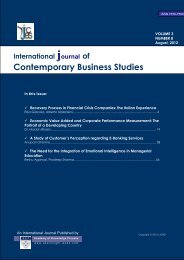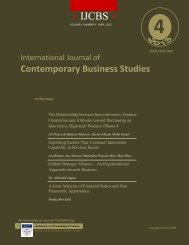International journal of Contemporary Business Studies
International journal of Contemporary Business Studies
International journal of Contemporary Business Studies
Create successful ePaper yourself
Turn your PDF publications into a flip-book with our unique Google optimized e-Paper software.
<strong>International</strong> Journal <strong>of</strong> <strong>Contemporary</strong> <strong>Business</strong> <strong>Studies</strong><br />
Vol: 3, No: 6. June, 2012 ISSN 2156-7506<br />
Available online at http://www.akpinsight.webs.com<br />
meta-construct consolidating firm level variables that support innovation. Five types managerial levers<br />
used are strategy, structure, resource allocation, organizational learning and knowledge management tool<br />
and culture (Crossan & Apaydin, 2010). Innovative organization faced dilemmas such as structure and<br />
action, dilemma with opposition <strong>of</strong> persistence and change or repetition and novelty which appeared as<br />
tensions between different time horizons (Chanal, 2004). In this context, managerial levers is used to<br />
overcome the innovation dilemmas (Chanal, 2004). The following discussions will describe each <strong>of</strong> the<br />
managerial levers.<br />
1.1Strategy<br />
The first managerial lever is strategy. Strategy has been perceived as a continuous management activities<br />
(Drejer, 2006; Li, Zhou, & Si, 2010). Indeed, it is an activity the most necessary form <strong>of</strong> and the<br />
foundation for innovation (Ian Steward & Peter Fenn, 2006). Strategy is needed in order to overcome<br />
managerial challenge which might arise from potential disruptive with existing resource endowments,<br />
capabilities and organizational routines (Blumentritt & Danis, 2006). Strategy is claimed to defined the<br />
gaps between the current and desired performance and thus it is vital for innovation in pursuing<br />
competitive advantage (Ian Steward & Peter Fenn, 2006). Therefore, the role <strong>of</strong> innovation and firm‟s<br />
innovative target should be linked with the competencies and strategic orientation <strong>of</strong> particular firm<br />
(Blumentritt & Danis, 2006). In fact, a study in manufacturing firms has showed that innovation strategy<br />
with formal structure are significant predictors <strong>of</strong> performance (Terziovski, 2010). Strategy managed to<br />
differentiate organizational pattern between the high innovation performance and the less successful ones<br />
(Pullen, Weerd-Nederh<strong>of</strong>, Groen, Song, & Fisscher, 2009).<br />
Innovation practices differ among firms with different strategic orientation (Blumentritt & Danis, 2006).<br />
For instance, the SMEs firms achieved high innovation performance combine both analyzer (used for<br />
incremental innovation) and prospector (used for radical innovation) business strategy (Pullen, et al.,<br />
2009).This is because strategy concerned the survival <strong>of</strong> entire organization and involved large portion <strong>of</strong><br />
resources and also strategic thinking <strong>of</strong> tactical level (Drejer, 2006). When discussed the importance <strong>of</strong><br />
strategy with innovation, Drejer (2006) has come out to define strategic innovation as the ability to<br />
create and revitalize the business idea and concept <strong>of</strong> the company by changing both the market <strong>of</strong> the<br />
company and the competencies and business system <strong>of</strong> the company. In an empirical study <strong>of</strong> Taiwanese<br />
electronics industry, found that product innovation is strongly related to differentiation strategy while the<br />
process innovation was strongly related to differentiation and cost leadership strategies (Liang-Hung &<br />
Chun-Hsien, 2008).<br />
Empirically, Blumentritt and Danis (2006) indicated that approaches to innovation vary across firms with<br />
different strategic orientation and firm‟s strategies played significant role in deciding which to pursue and<br />
which to disregard. As mention by Y. Chen and Yuan (2007), a firm needs to seek optimal balance<br />
between internal R&D and technology outsourcing when formulating innovation strategy. Innovation<br />
which is oriented by strategy is essential in determining organization direction in the long run, generate<br />
innovativeness and contribute to the different pattern <strong>of</strong> innovation orientation (Stock & Zacharias, 2011).<br />
For instance, it is found that innovation orientation <strong>of</strong> strategy contributed high scores to integrated<br />
innovator and top-down innovator while scored low to the internally driven and proactive customer<br />
innovator type (Stock & Zacharias, 2011). In a case study <strong>of</strong> Chinese firms, Q. Xu, Liu, and Chen (2002)<br />
have argued the use <strong>of</strong> knowledge strategy to be integrate with technological innovation to ensure<br />
companies effective and efficient. This is important due to the fast changing environment and firm need<br />
to articulate knowledge strategy to stimulate innovative activities (Xu, et al., 2002).<br />
Various elements and measures are used to represent strategy in relation to innovation study. A study <strong>of</strong><br />
600 Australian small and medium enterprises <strong>of</strong> manufacturing sector, the innovation strategy has<br />
emphasize on vision or mission, strategic goals, increase in production, customer satisfaction,<br />
administrative, employee skill and employee commitment (Terziovski, 2010). While Stock and Zacharias<br />
Copyright © 2012. Academy <strong>of</strong> Knowledge Process<br />
7
















